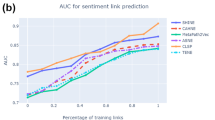Abstract
Mention is an important interactive behavior used to explicitly refer to target users for specific information in social networks. Understanding user mention behavior can provide important insights into questions of human social behavior and improve design of social network platforms. However, most previous works mainly focus on mentioning for the effect of information diffusion, few researches consider the problem of mention behavior prediction. In this paper, we propose an intuitive approach to predict user mention behavior using link prediction method. Specifically, we first formulate user mention prediction problem as a classification task, and then extract new features including semantic interest match, social tie, mention momentum and interaction strength to improve the performance of prediction. To evaluate the proposed approach, we conduct extensive experiments on Twitter dataset. The experimental results clearly show that our approach has 15% increase in precision compared with the best baseline method.
Preview
Unable to display preview. Download preview PDF.
Similar content being viewed by others
References
Abel, F., Gao, Q., Houben, G.J., Tao, K.: Analyzing temporal dynamics in twitter profiles for personalized recommendations in the social web. In: Proceedings of the 3rd International Web Science Conference, p. 2. ACM (2011)
Adamic, L.A., Adar, E.: Friends and neighbors on the web. Social networks 25(3), 211–230 (2003)
Al Hasan, M., Zaki, M.J.: A survey of link prediction in social networks. In: Aggarwal, C.C. (ed.) Social Network Data Analytics, pp. 243–275. Springer, Heidelberg (2011)
Batuwita, R., Palade, V.: Class imbalance learning methods for support vector machines. In: Imbalanced Learning: Foundations, Algorithms, and Applications, pp. 83–99 (2013)
Derczynski, L., Maynard, D., Aswani, N., Bontcheva, K.: Microblog-genre noise and impact on semantic annotation accuracy. In: Proceedings of the 24th ACM Conference on Hypertext and Social Media, pp. 21–30 (2013)
Hong, L., Davison, B.D.: Empirical study of topic modeling in twitter. In: Proceedings of the First Workshop on Social Media Analytics, pp. 80–88 (2010)
Itakura, K.Y., Sonehara, N.: Using twitter’s mentions for efficient emergency message propagation. In: 2013 Eighth International Conference on Availability, Reliability and Security (ARES), pp. 530–537 (2013)
Pramanik, S., Danisch, M., Wang, Q., Mitra, B.: An empirical approach towards an efficient "whom to mention?" Twitter app
Ritter, A., Clark, S., Etzioni, O.: Named entity recognition in tweets: an experimental study. In: Proceedings of the Conference on Empirical Methods in Natural Language Processing, pp. 1524–1534 (2011)
Tang, L., Ni, Z., Xiong, H., Zhu, H.: Locating targets through mention in Twitter. World Wide Web, pp. 1–31 (2014)
Vapnik, V.: The nature of statistical learning theory. Springer Science & Business Media (2013)
Wang, B., Wang, C., Bu, J., Chen, C., Zhang, W.V., Cai, D., He, X.: Whom to mention: expand the diffusion of tweets by@ recommendation on micro-blogging systems. In: Proceedings of the 22nd International Conference on World Wide Web, pp. 1331–1340 (2013)
Yang, J., Counts, S.: Predicting the speed, scale, and range of information diffusion in twitter. In: ICWSM, pp. 355–358 (2010)
Yu, M., Yang, W., Wang, W., Shen, G., Dong, G.: Information diffusion and influence measurement based on interaction in microblogging. In: Huang, H., Liu, T., Zhang, H.-P., Tang, J. (eds.) SMP 2014. CCIS, vol. 489, pp. 129–140. Springer, Heidelberg (2014)
Al Hasan, M., Chaoji, V., Salem, S., Zaki, M.: Link prediction using supervised learning. In: SDM (2006)
Author information
Authors and Affiliations
Corresponding author
Editor information
Editors and Affiliations
Rights and permissions
Copyright information
© 2015 Springer International Publishing Switzerland
About this paper
Cite this paper
Jiang, B., Sha, Y., Wang, L. (2015). Predicting User Mention Behavior in Social Networks. In: Li, J., Ji, H., Zhao, D., Feng, Y. (eds) Natural Language Processing and Chinese Computing. NLPCC 2015. Lecture Notes in Computer Science(), vol 9362. Springer, Cham. https://doi.org/10.1007/978-3-319-25207-0_13
Download citation
DOI: https://doi.org/10.1007/978-3-319-25207-0_13
Published:
Publisher Name: Springer, Cham
Print ISBN: 978-3-319-25206-3
Online ISBN: 978-3-319-25207-0
eBook Packages: Computer ScienceComputer Science (R0)




